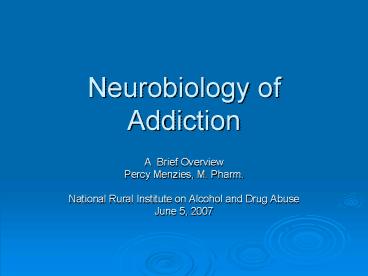Neurobiology of Addiction - PowerPoint PPT Presentation
1 / 20
Title:
Neurobiology of Addiction
Description:
... brain and connected by complex neurocircuitary to the reward/pleasure centers ... within the motivational and memory centers co-located in the limbic system. ... – PowerPoint PPT presentation
Number of Views:207
Avg rating:3.0/5.0
Title: Neurobiology of Addiction
1
Neurobiology of Addiction
- A Brief Overview
- Percy Menzies, M. Pharm.
- National Rural Institute on Alcohol and Drug
Abuse - June 5, 2007
2
Objectives
- Drive state and survival of the species
- How do drugs work?
- Definition of Abuse and Dependence
- The Pleasure Pathways of the Brain
- Neurotransmitters
- Components of treatment
3
Drive States
- Higher organisms have inherent instincts that are
essential for the survival of the species - These instincts drive them to
- Seek/obtain food Seek/make shelter
- Seek/obtain water Protect the young
- Seek/have sex
- These drive states are located in the specific
part of the brain and connected by complex
neurocircuitary to the reward/pleasure centers
4
Drive States
- Each drive state has two aspects
- If the drive state is achieved the organism
experiences reward which is pleasure,
satisfaction and sense of well being - If the drive state in frustrated or cannot be
met, the organism experiences dysphoria, anxiety,
irritability and anger
5
How Do Drugs Work?
- Drugs bypass the instinctual drives and cause
an abnormal stimulation of the reward/pleasure
system - Stimulation of the reward/pleasure system by
drive states PHYSIOLOGY - Stimulation of the reward/pleasure system by
drugs PATHOLOGY
6
What is Addiction?
- Addiction is a disorder/disease of the
REWARD/PLEASURE system of the brain. It is
characterized by four primary symptoms - Craving
- Loss of control
- Tolerance
- Continued use despite adverse consequences
7
DSM Criteria for Drug Abuse
- Drug Abuse
- Recurrent use leading to failure to fulfill major
obligations - Recurrent use which is physically hazardous
- Recurrent drug-related legal problems
- Continued use despite social or interpersonal
problems
8
DSM Criteria for Drug Dependence
- Tolerance to the drugs action
- Withdrawal
- Drug is used more than intended
- There is inability to control drug use
- Effort is expended to obtain the drug
- Important activities are replaced by drug use
- Drug use continues in spite of negative
consequences
9
The Pleasure Pathways of the Brain
- Ventral Tegmental Area
- Lateral Hypothalamus
- Nucleus Accumbens
- Prefrontal Cotrex
- Drug addiction affects the reward circuitry
within the motivational and memory centers
co-located in the limbic system. Memory plays a
critical role in relapse.
10
Neurotransmitter of Addiction
- Dopamine
- Serotonin
- Endorphins
- Gamma Amino Butyric Acid (GABA)
11
Dopamine
- Reward neurotransmitter
- Found in the medial forebrain bundle
- May be stimulated directly by drugs like cocaine
- Stimulated by the release of endorphins
12
Serotonin
- Normalizing neurotransmitter
- Found in the limbic system
- Key role in the deficiency hypothesis of
depression and craving - SSRI drugs increase levels of serotonin to
alleviate depression
13
Endorphins
- Analgesia neurotransmitters
- Found in the hypothalamus and the limbic system
- Key role in stress, pain, craving and relapse
- Stimulation of the dopamine system
- Act specifically on the opioid receptors
14
Gamma Amino Butyric Acid (GABA)
- Inhibitory neurotransmitter
- Role in the loss of inhibitions and acute
intoxications - Unproved theory that GABA deficiency causes
alcoholism - Benzodiazepines act on this neurotransmitter
15
Progression of AddictionNeuroadaption
- A process by which receptors in the
reward/pleasure centers of the brain adapt to
higher concentrations of the neurotransmitters.
The receptors become insensitive to normal levels
of neurotransmitters.
16
Effects of Neuroadaptation
- Under unstimulated conditions there is a profound
interference in the ability to experience
pleasure the user feels an unmet instinctive
drive leading to craving dysphoria, anxiety and
frustration - TOLERANCE- Forces the user to escalate the dose
to experience a high. Using an inadequate dose
causes withdrawal symptoms
17
Effects of Neuroadaptation
- Length of use and intensity of the drug are
factors predicting the damage to the
reward/pleasure centers called COUNTERADAPTATION
. The patient has to use drugs/alcohol just feel
less bad
18
Factors Contributing to Addiction
- Genetics
- Learning/behavioral factors
- Familial
- Co-morbidities
- Access
19
Role of Genetics
- There is no single gene that determines or
protects from addiction - Genes interact with the environment to influence
susceptibility - Genes can predispose, but cannot determine the
level of risk - Genetic predisposition is a warning not fate
20
Components of Drug Treatment
- Detoxification the use of medications to treat
withdrawal symptoms. If in adequately treated,
the patients feels compelled to use drugs.
Inadequate detoxification procedures are a major
cause of lapses and relapse - Relapse Prevention Behavioral modification
extinguish triggers that lead to cravings
controlled reentry to cue rich environments































